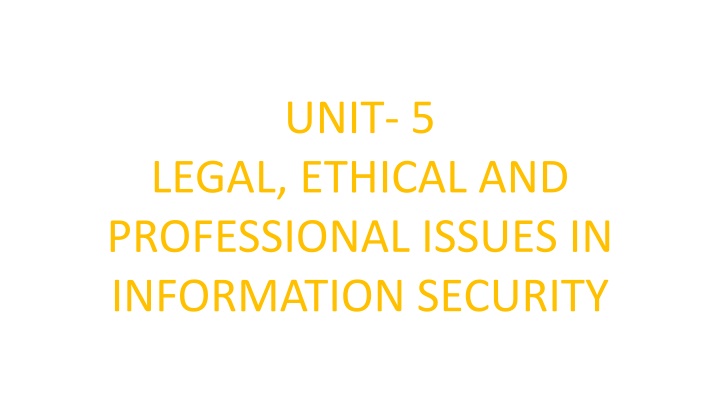
Legal and Ethical Responsibilities in Information Security
Explore the importance of legal and ethical considerations in information security, including the impact on organizational liability and the need for ethical behavior. Learn about laws, ethics, and the consequences of unethical actions for employees and organizations.
Download Presentation

Please find below an Image/Link to download the presentation.
The content on the website is provided AS IS for your information and personal use only. It may not be sold, licensed, or shared on other websites without obtaining consent from the author. If you encounter any issues during the download, it is possible that the publisher has removed the file from their server.
You are allowed to download the files provided on this website for personal or commercial use, subject to the condition that they are used lawfully. All files are the property of their respective owners.
The content on the website is provided AS IS for your information and personal use only. It may not be sold, licensed, or shared on other websites without obtaining consent from the author.
E N D
Presentation Transcript
UNIT- 5 LEGAL, ETHICAL AND PROFESSIONAL ISSUES IN INFORMATION SECURITY
INTRODUCTION You must understand scope of an organization s legal and ethical responsibilities . To minimize liabilities/reduce risks, the information security practitioner must: Understand current legal environment Stay current with laws and regulations Watch for new issues that emerge
LAWS AND ETHICS IN INFORMATION SECURITY LAWS- The rules the members of a society create to balance the individual rights to self-determination against the needs of the society as a whole. ETHICS- It is defined as socially acceptable behaviors. Laws are rules that mandate or prohibit certain behavior; they are drawn from ethics. The key difference between laws and ethics is that laws carry the authority of a governing body, and ethics do not.
LAWS AND ETHICS IN INFORMATION SECURITY Ethics in turn are based on cultural mores: the fixed moral attitudes or customs of a particular group. Some ethical standards are universal. For example, murder, theft, assault, and arson are actions that deviate from ethical and legal codes throughout the world.
ORGANISATIONAL LIABILITY AND THE NEED FOR COUNSEL What if an organization does not demand or even encourage strong ethical behavior from its employees? What if an organization does not behave ethically? Even if there is no breach of criminal law, there can still be liability. Liability is the legal obligation of an entity that extends beyond criminal or contract law; It includes the legal obligation to make restitution, or to compensate for wrongs committed
ORGANISATIONAL LIABILITY AND THE NEED FOR COUNSEL The bottom line is that if an employee, acting with or without the authorization of the employer, performs an illegal or unethical act that causes some degree of harm, the employer can be held financially liable for that action. An organization increases its liability if it refuses to take measures known as due care. Due care standards are met when an organization makes sure that every employee knows what is acceptable or unacceptable behavior, knows the consequences of illegal or unethical actions.
ORGANISATIONAL LIABILITY AND THE NEED FOR COUNSEL Due diligence requires an organization make a valid effort to protect others and continually maintains this level of effort. Long arm jurisdiction the long arm of the law extending across the country or around the world to draw an accused individual into its court systems.
POLICY VERSUS LAW Policies Guidelines that describe acceptable and unacceptable employee behaviors. Functions as organizational laws. Has penalties, judicial practices, and sanctions. Difference between policy and law- Ignorance of policy is acceptable. Ignorance of law is unacceptable.
POLICY VERSUS LAW Keys for a policy to be enforceable Dissemination- Distributed to all individuals who are expected to comply with them. Review- Readily available for employee reference Comprehension- Easily understood, with multilingual, visually impaired and low- literacy translations. Compliance- Acknowledged by employee with consent form. Uniform enforcement- Enforced for all employees, regardless their status or assignment.
CYBER CRIME At the Tenth United Nations Congress on the Prevention of Crime and Treatment of Offenders, cybercrime was broken into two categories and defined as: a. Cybercrime in a narrow sense (computer crime): Any illegal behaviour directed by means of electronic operations that targets the security of computer systems and the data processed by them. b. Cybercrime in a broader sense (computer-related crime): Any illegal behavior committed by means of a computer system or network, including such crimes as illegal possession [and] offering or distributing information by means of a computer system or network.
CYBER CRIME The OECD Recommendations of 1986 included a working definition as a basis for the study: Computer-related crime is considered as any illegal, unethical or unauthorized behaviour relating to the automatic processing and the transmission of data. Cyber frauds in India As per the report, at least 1,15,000 people fall prey to cyber fraud every day, while 80 per minute and more than one per second leading to a rise in the average direct financial cost per victim to around Rs10,500.
FIRST CYBER CRIME The first recorded cyber crime took place in the year 1820! That is not surprising considering the fact that the abacus, which is thought to be the earliest form of a computer, has been around since 3500 B.C. in India, Japan and China. The era of modern computers, however, began with the analytical engine of Charle Babbage. In 1820, Joseph- Marie Jacquard, a textile manufacturer in France, produced the loom. This device allowed the repetition of a series of steps in the weaving of special fabrics. This resulted in a fear amongst Jacquard's employees that their traditional employment and livelihood were being threatened. They committed acts of sabotage to discourage Jacquard from further use of the new technology. This is the first recorded cyber crime!
CYBER CRIMES FOUND IN INDIA 1. Cyber pornography (Delhi Public School case) 2. Sale of illegal articles: E.g. many of the auction sites even in India are believed to be selling cocaine in the name of honey . Online gambling: Cases of hawala transactions and money laundering over the Internet have been reported. A man called Kola Mohan invented the story of winning the Euro Lottery. He himselfcreated a website and an email address on the Internet with the address 'eurolottery@usa.net.' Whenever accessed, the site would name him as the beneficiary of the 12.5 million pound. After confirmation a Telugu newspaper published this as a news. He collected huge sums from the public as well as from some banks for mobilization of the deposits in foreign currency. However, the fraud came to light when a cheque discounted by him with the Andhra Bank for Rs 1.73 million bounced. Mohan had pledged with Andhra Bank the copy of a bond certificate purportedly issued by Midland Bank, Sheffields, London stating that a term deposit of 12.5 million was held in his name. 3.
CYBER CRIMES FOUND IN INDIA 4. Intellectual Property crimes: Yahoo had sued one Akash Arora for use of the domain name Yahooindia.Com deceptively similar to its Yahoo.com . As this case was governed by the Trade Marks Act, 1958, the additional defence taken against Yahoo s legal action for the interim order was that the Trade Marks Act was applicable only to goods. 5. Email spoofing : Example- An Executive s case, where he pretended to be a girl and cheated an Abu dhabi based NRI for crores by blackmailing tactics. 6. Unauthorized access to computer systems or networks : Dr. Nuker , who claims to be the founder of Pakistan Hackerz Club, reportedly hacked the websites of the Indian Parliament, Ahmedabad Telephone Exchange, Engineering Export Promotion Council, and United Nations (India).
CYBER CRIMES FOUND IN INDIA 7. Email bombing: a foreigner who had been residing in Shimla, India for almost thirty years wanted to avail of a scheme introduced by the Shimla Housing Board to buy land at lower rates. When he made an application it was rejected on the grounds that the scheme was available only for citizens of India. He decided to take his revenge. Consequently he sent thousands of mails to the Simla Housing Board and repeatedly kept sending e-mails till their servers crashed. 8. Salami attacks: E.g. A bank employee inserts a program, into the bank s servers, that deducts a small amount of money (say Rs. 5 a month) from the account of every customer. No account holder will probably notice this unauthorized debit, but the bank employee will make a sizeable amount of money every month.
CYBER CRIMES FOUND IN INDIA 9. Trojan Attack: To cite an example, two friends Rahul and Mukesh (names changed), had a heated argument over one girl, Radha (name changed) whom they both liked. When the girl, asked to choose, chose Mukesh over Rahul, Rahul decided to get even. On the 14th of February, he sent Mukesh a spoofed e-card, which appeared to have come from Radha s mail account. The e-card actually contained a Trojan. As soon as Mukesh opened the card, the Trojan was installed on his computer. Rahul now had complete control over Mukesh s computer and proceeded to harass him thoroughly.
CYBER CRIMES FOUND IN INDIA 10. Cyber stalking: The Oxford dictionary defines stalking as pursuingstealthily . Cyber stalking involves following a person s movements across the Internet by posting messages (sometimes threatening) on the bulletin boards frequented by the victim, entering the chat-rooms frequented by the victim, constantly bombarding the victim with emails etc..
WHO COMMITS CYBER CRIME? i. Insiders - Disgruntled employees and ex-employees, spouses, lovers ii. Hackers - Crack into networks with malicious intent iii. Virus Writers - Pose serious threats to networks and systems worldwide iv. Foreign Intelligence - Use cyber tools as part of their Services for espionage activities and can pose the biggest threat to the security of another country v. Terrorists - Use to formulate plans, to raise funds, propaganda
CYBER CRIME ON THE RISE As per the cyber crime data maintained by the National Crime Records Bureau (NCRB) INFORMATION TECHNOLOGY ACT,2000 2007 2008 2009 2010 CASES FILED 217 288 420 966 ARRESTED 154 178 288 799 C YBER CRIME, INDIAN PENEL CODE (IPC) 2007 2008 2009 2010 CASES FILED 328 176 276 356 ARRESTED 429 195 263 294
CYBER CRIME ON THE RISE As per 2011 NCRB figures, there were 1791 cases registered under the IT Act during the year 2011 as compared to 966 cases during the previous year (2010) thereby reporting an increase of 85.4% in 2011 over 2010. Of this, 19.5% cases (349 out of 1791 cases) were reported from Andhra Pradesh followed by Maharashtra (306), Kerala (227), Karnataka (151) and Rajasthan (122). And 46.1% (826 cases) of the total 1791 cases registered under IT Act, 2000 were related to loss/damage to computer resource/utility reported under hacking with computer systems. According to NCRB, the police have recorded less than 5000; only 4829 cases and made fewer arrests (3187) between 2007-2011, under both the Information Technology (IT) Act as well as the Indian Penal Code (IPC).
CYBER CRIME ON THE RISE Out of total 157 cases relating to hacking under Sec. 66(2), most of the cases (23 cases) were reported from Karnataka followed by Kerala (22 ) and Andhra Pradesh (20 cases). And 20.4% of the 1184 persons arrested in cases relating to IT Act, 2000 were from Andhra Pradesh (242) followed by Maharashtra (226). The age-wise profile of persons arrested in cyber crime cases under the IT Act, 2000 showed that 58.6% of the offenders were in the age group 18 30 years (695 out of 1184) and 31.7% of the offenders were in the age group 30-45 years (376 out of 1184). Madhya Pradesh (10), Maharashtra (4), Kerala (3) and Delhi (2) reported offenders whose age was below 18years.
CYBER CRIME ON THE RISE Bangalore (117), Vishakhapatnam (107), Pune (83), Jaipur (76), Hyderabad (67) and Delhi (City) (50) have reported high incidence of cases (500 out of 858 cases) registered under IT Act, accounting for more than half of the cases (58.3%) reported under the IT Act. India has seen a total of 1.71 lakh cybercrimes in the past three-and- half-years and the number of crimes so far this year (27,482) indicate the total number is likely to cross 50,000 by December. At least one cybercrime was reported every 10 minutes in India in first six months of 2017. That s higher than a crime every 12 minutes in 2016.
CYBER LAW OF INDIA In India, cyber laws are contained in the Information Technology Act, 2000 ("IT Act") which came into force on October 17, 2000. The main purpose of the Act is to provide legal recognition to electronic commerce and to facilitate filing of electronic records with the Government. The following Act, Rules and Regulations are covered under cyber laws: 1. Information Technology Act, 2000 2. Information Technology (Certifying Authorities) Rules, 2000 3. Information Technology (Security Procedure) Rules, 2004 4. Information Technology (Certifying Authority) Regulations, 2001
NEED FOR CYBER LAW IN INDIA Firstly, India has an extremely detailed and well-defined legal system in place. Numerous laws have been enacted and implemented and the foremost amongst them is The Constitution of India. However the arrival of Internet signalled the beginning of the rise of new and complex legal issues. It may be pertinent to mention that all the existing laws in place in India were enacted way back keeping in mind the relevant political, social, economic, and cultural scenario of that relevant time. Nobody then could really visualize about the Internet. Despite the brilliant acumen of our master draftsmen, the requirements of cyberspace could hardly ever be anticipated. As such, the coming of the Internet led to the emergence of numerous ticklish legal issues and problems which necessitated the enactment of Cyber laws.
NEED FOR CYBER LAW IN INDIA Secondly, the existing laws of India, could not be interpreted in the light of the emerging cyberspace, to include all aspects relating to different activities in cyberspace. In fact, the practical experience and the wisdom of judgment found that it shall not be without major perils and pitfalls, if the existing laws were to be interpreted in the scenario of emerging cyberspace, without enacting new cyber laws. Hence,the need for enactment of relevant cyber laws.
NEED FOR CYBER LAW IN INDIA Thirdly, none of the existing laws gave any legal validity or sanction to the activities in Cyberspace. For example, the Net is used by a large majority of users for email. Yet till today, email is not "legal" in our country. There is no law in the country, which gives legal validity, and sanction to email. Courts and judiciary in our country have been reluctant to grant judicial recognition to the legality of email in the absence of any specific law having been enacted by the Parliament. As such the need has arisen for Cyber law.
NEED FOR CYBER LAW IN INDIA Fourthly, Internet requires an enabling and supportive legal infrastructure in tune with the times. This legal infrastructure can only be given by the enactment of the relevant Cyber laws as the traditional laws have failed to grant the same. E-commerce, the biggest future of Internet, can only be possible if necessary legal infrastructure compliments the same to enable its vibrant growth.
CASE LAWS Avnish Bajaj Vs. State (N.C.T.) of Delhi Avnish Bajaj CEO of Baazee.com, a customer-to-customer website, which facilitates the online sale of property. Baazee.com receives commission from such sales and also generates revenue from advertisements carried on its web pages. An obscene MMS clipping was listed for sale on Baazee.com on 27th November, 2004 in the name of DPS Girl having fun . Some copies of the clipping were sold through Baazee.com and the seller received the money for the sale. Avnish Bajaj was arrested under section 67 of the Information Technology Act, 2000. The arguments of the defendant were that - Section 67 of the Information Technology Act relates to publication of obscene material. It does not relate to transmission of such material. On coming to learn of the illegal character of the sale, remedial steps were taken within 38 hours, since the intervening period was a weekend.
CASE LAWS The findings of the Court It has not been established from the evidence that any publication took place by the accused, directly or indirectly. The actual obscene recording/clip could not be viewed on the portal of Baazee.com. The sale consideration was not routed through the accused. Prima facie Baazee.com had endeavored to plug the loophole. The accused had actively participated in the investigations. The nature of the alleged offence is such that the evidence has already crystallized and may even be tamper proof. Even though the accused is a foreign citizen, he is of Indian origin with family roots in India.
CASE LAWS The evidence that has been collected indicates only that the obscene material may have been unwittingly offered for sale on the website. The evidence that has been collected indicates that the heinous nature of the alleged crime may be attributable to some other person. The court granted bail to Mr. Bajaj subject to furnishing two sureties of Rs. 1 lakh each. The court ordered Mr. Bajaj to surrender his passport and not to leave India without the permission of the Court. The court also ordered Mr.Bajaj to participate and assist in the investigation.






















